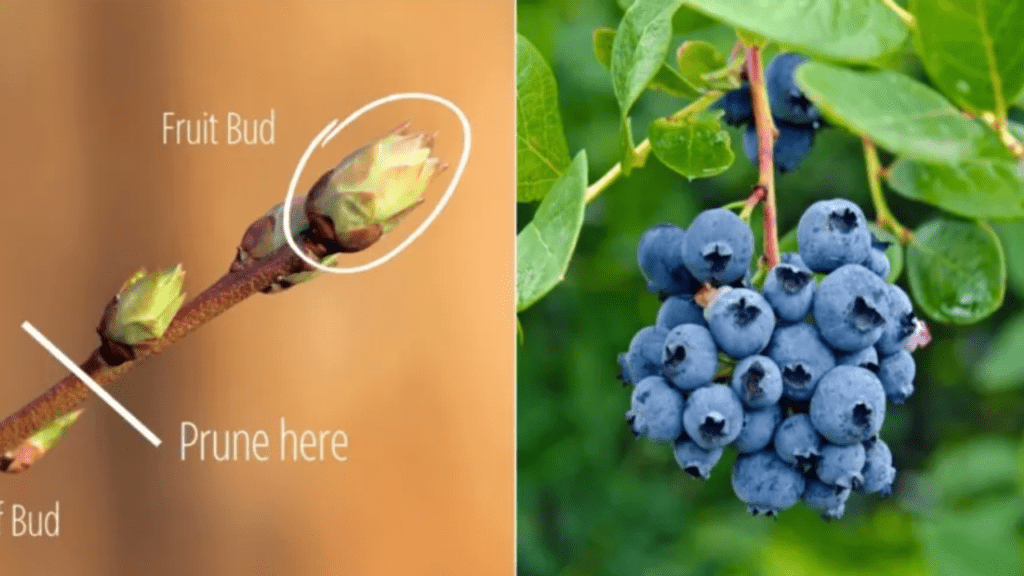
Pruning Blueberry Bushes: When and How to Do It Right
Blueberry bushes are a rewarding addition to any garden, offering delicious fruit and attractive foliage. However, to ensure your blueberry bushes remain healthy and produce an abundant harvest, pruning blueberry bushes is a vital task. Proper pruning not only enhances the plant’s overall health but also encourages the growth of larger, more flavorful berries. In this guide, we will walk you through everything you need to know about pruning blueberry bushes, from the best time to prune to the step-by-step process of trimming your plants.
Table of Contents
ToggleWhy Pruning is Essential for Blueberry Bushes
Discuss the benefits of pruning, including improved air circulation, sunlight penetration, and overall plant health.
Pruning blueberry bushes is essential for their overall health and productivity. By removing dead or diseased branches, you can improve air circulation within the bush, reducing the risk of mold and mildew. Additionally, pruning allows sunlight to penetrate the plant, promoting better fruit development and ripening. It also stimulates new growth, leading to a more robust and productive bush. Overall, pruning helps to maintain the shape and structure of the plant, ensuring it remains healthy and vibrant. By taking the time to prune your blueberry bushes, you can enjoy a bountiful harvest of delicious, high-quality fruit.
Explain how regular pruning helps in achieving higher yields and larger berries.
Regular pruning is essential for achieving higher yields and larger berries from your blueberry bushes. By regularly pruning your blueberry bushes, you can remove dead or diseased branches, allowing for improved air circulation and reducing the risk of mold and mildew. This promotes overall plant health and ensures that your bushes are able to produce an abundance of high-quality fruit. Pruning also allows sunlight to penetrate the plant, which is essential for promoting better fruit development and ripening. Additionally, the process of pruning stimulates new growth, leading to a more robust and productive bush. By maintaining the shape and structure of the plant through regular pruning, you can ensure that your blueberry bushes remain healthy and vibrant, ultimately leading to a bountiful harvest of delicious, larger berries. Overall, regular pruning is a key factor in maximizing the productivity and quality of your blueberry bushes.
When to Prune Blueberry Bushes
Subsection: Ideal Pruning Time
Highlight the best times of year to prune blueberry bushes, focusing on late winter to early spring.
Pruning your blueberry bushes is essential for maintaining their health and productivity. It helps to improve air circulation, sunlight penetration, and overall plant health. Regular pruning also leads to higher yields and larger berries, making it a vital task for any blueberry grower.
The best time to prune blueberry bushes is in late winter to early spring, before new growth begins. This is typically around late February to early March, depending on your specific climate and growing zone. Pruning during this time allows the bushes to recover and develop new growth before the fruiting season begins.
During this time, you can remove any dead or damaged wood, as well as any weak or crowded branches. It’s also a good opportunity to shape the bushes and encourage new growth from the base. Remember to use sharp, clean pruning shears to make clean cuts and minimize the risk of disease.
By following these guidelines and pruning your blueberry bushes at the right time, you can help ensure a healthy, productive harvest of delicious blueberries.
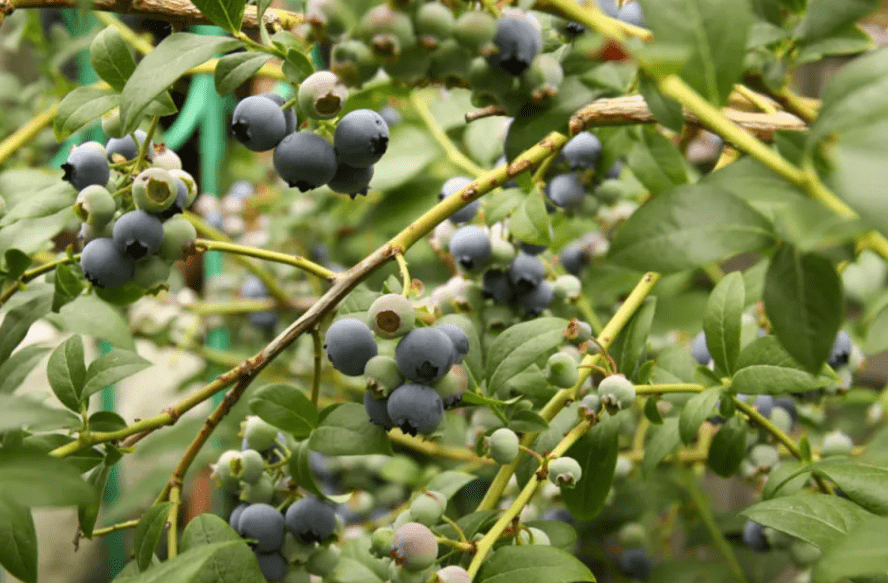
Explain the reasons behind choosing this time, such as dormancy and minimal impact on growth.
The best time to prune blueberry bushes is in late winter to early spring, before new growth begins. This timing is ideal because the bushes are in a state of dormancy, which allows for minimal impact on their growth. Pruning during this time also gives the bushes the opportunity to recover and develop new growth before the fruiting season begins. It’s important to remove any dead or damaged wood, as well as any weak or crowded branches during this time. Additionally, shaping the bushes and encouraging new growth from the base can help promote a healthier and more productive harvest of delicious blueberries. Using sharp, clean pruning shears is essential to make clean cuts and minimize the risk of disease. By following these guidelines and pruning your blueberry bushes at the right time, you can help ensure the health and productivity of your blueberry plants.
Subsection: Regional Considerations
Discuss how pruning times may vary depending on climate and geographical location.
The best time to prune blueberry bushes can vary depending on the climate and geographical location. In warmer climates, where the winter is mild, it may be best to prune blueberry bushes in late winter. In colder climates, where the winter is harsh, it may be better to wait until early spring to prune the bushes. It’s important to consider the specific conditions of your region when determining the best time for pruning. By taking into account the climate and geographical location, you can ensure that your blueberry bushes receive the best care and maintenance for optimal growth and fruit production.
Provide a brief guide for different regions.
Pruning blueberry bushes at the right time is essential for their health and productivity. When it comes to regional considerations, the best time to prune blueberry bushes can vary depending on the climate and geographical location. In warmer climates with mild winters, it may be best to prune blueberry bushes in late winter. However, in colder climates with harsh winters, it may be better to wait until early spring to prune the bushes. It’s important to consider the specific conditions of your region when determining the best time for pruning. By taking into account the climate and geographical location, you can ensure that your blueberry bushes receive the best care and maintenance for optimal growth and fruit production. So, it’s essential to research or consult with local experts to determine the most appropriate pruning schedule for your specific region.
How to Prune Blueberry Bushes
Subsection: Tools You’ll Need
List essential pruning tools, such as pruning shears, loppers, and gloves.
When pruning blueberry bushes, it is important to have the right tools on hand. Some essential pruning tools include pruning shears, loppers, and gloves. Pruning shears are used for cutting small branches and stems, while loppers are used for thicker branches. Both of these tools are important for shaping and maintaining the health of the blueberry bushes. Additionally, wearing gloves is essential to protect your hands from thorns and other potential hazards while pruning. Having the right tools on hand will make the pruning process much more efficient and effective, ultimately leading to healthier and more productive blueberry bushes.
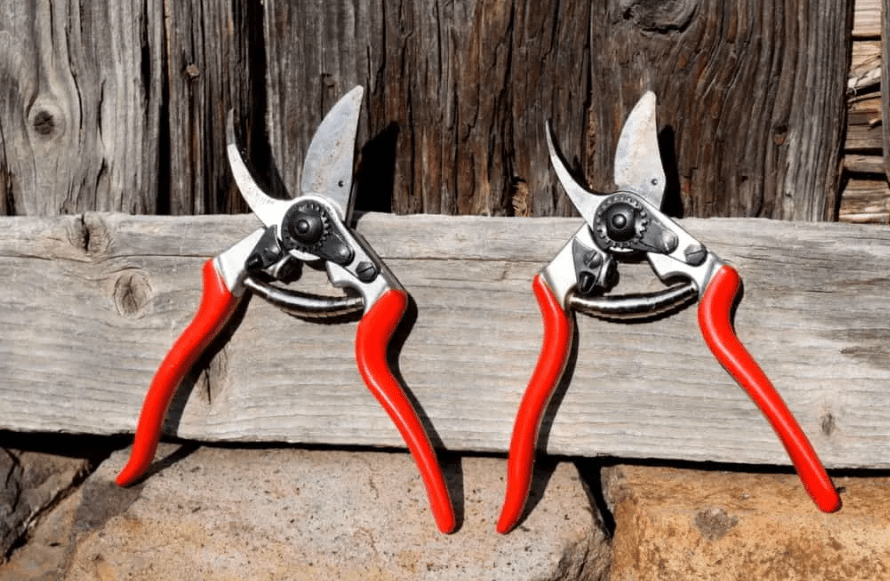
Offer tips on maintaining and sharpening tools for efficient pruning.
Maintaining and sharpening your pruning tools is essential for efficient and effective pruning. To keep your tools in top condition, it’s important to regularly clean and oil them to prevent rust and corrosion. You should also regularly sharpen the blades of your pruning shears and loppers to ensure clean and precise cuts. Using a sharpening stone or file, carefully sharpen the blades at a 20-30 degree angle, being sure to maintain the original bevel. Additionally, it’s important to replace any damaged or worn out parts, such as blades or springs, to ensure that your tools are working at their best. By maintaining and sharpening your pruning tools, you’ll be able to make clean, precise cuts, leading to healthier and more productive plants.
Subsection: Step-by-Step Pruning Process
Provide a detailed, step-by-step guide on how to prune blueberry bushes.
Step 1: Start by removing any dead or diseased wood from the blueberry bush. Use pruning shears or loppers to make clean cuts at a 45-degree angle to promote healing.
Step 2: Next, look for any branches that are crossing or rubbing against each other. These branches can cause damage and should be pruned back to the main stem.
Step 3: Remove any weak or spindly growth to encourage stronger, more productive branches to develop.
Step 4: Thin out the canopy of the bush by removing some of the older, thicker branches to allow more sunlight and air to reach the center of the plant.
Step 5: After pruning, be sure to clean up any debris and dispose of it properly to prevent the spread of disease.
Step 6: Once the pruning is complete, water the bush thoroughly and apply a layer of mulch around the base to help retain moisture and suppress weeds.
By following these steps, you can ensure that your blueberry bushes are properly pruned and set up for a healthy and productive growing season.
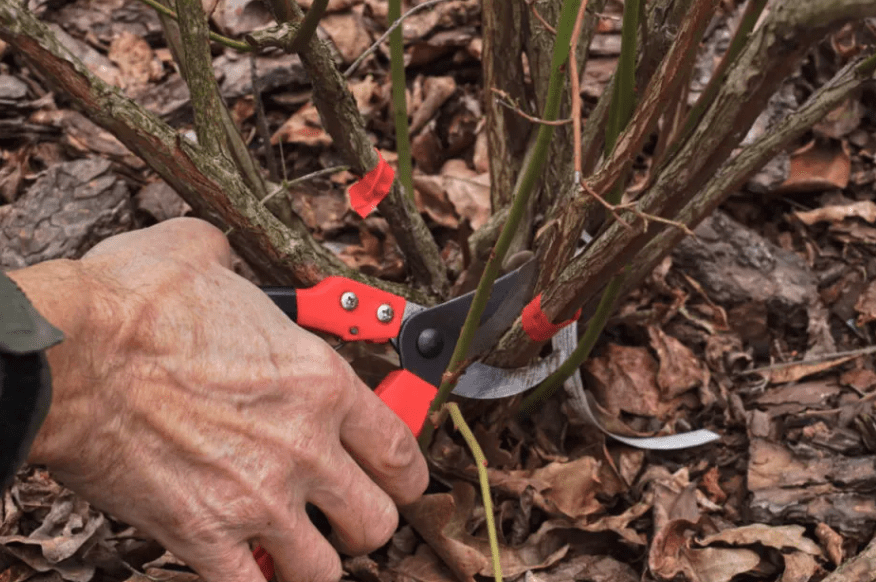
Include instructions on identifying and removing dead, diseased, or crossing branches.
Pruning your blueberry bushes is an important part of maintaining their health and productivity. To properly prune your bushes, you’ll want to start by identifying any dead, diseased, or crossing branches. These branches can inhibit the growth and fruit production of the bush, so it’s important to remove them. Look for branches that are crossing or rubbing against each other, as these can cause damage and should be pruned back to the main stem. Additionally, remove any weak or spindly growth to encourage stronger, more productive branches to develop. Thin out the canopy of the bush by removing some of the older, thicker branches to allow more sunlight and air to reach the center of the plant. After pruning, be sure to clean up any debris and dispose of it properly to prevent the spread of disease. Finally, water the bush thoroughly and apply a layer of mulch around the base to help retain moisture and suppress weeds. Following these steps will ensure that your blueberry bushes are properly pruned and set up for a healthy and productive growing season.
Discuss thinning cuts, heading cuts, and rejuvenation pruning.
Thinning cuts, heading cuts, and rejuvenation pruning are important techniques to ensure the health and productivity of your blueberry bushes. Thinning cuts involve removing branches that are inhibiting growth and fruit production, as well as any crossing or rubbing branches that could cause damage. By thinning out the canopy of the bush, you allow more sunlight and air to reach the center of the plant, promoting healthier growth. Heading cuts involve trimming back the tips of branches to encourage new growth and shape the plant. Rejuvenation pruning involves removing older, unproductive branches to stimulate new growth and improve the overall health of the bush. It’s important to follow these pruning techniques to ensure that your blueberry bushes remain healthy and productive.
Subsection: Common Pruning Mistakes to Avoid
Highlight common errors made during pruning and how to avoid them.
Pruning blueberry bushes is essential for their health and productivity, but it’s important to avoid common mistakes. One common mistake is making improper cuts, such as cutting too close to the main stem or leaving too long of a stub. This can lead to disease and insect infestation. Another mistake is over-pruning, which can weaken the plant and reduce fruit production. It’s important to follow proper pruning techniques and not to prune too aggressively. Additionally, timing is important when it comes to pruning. Pruning at the wrong time of year can negatively impact the plant’s growth and fruit production. To avoid these mistakes, it’s important to educate yourself on proper pruning techniques and to carefully follow guidelines for timing and frequency of pruning. By doing so, you can ensure the health and productivity of your blueberry bushes.
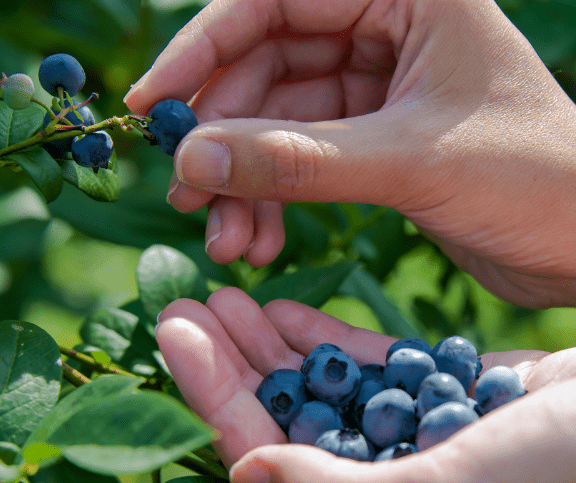
Offer advice on how to correct mistakes and recover from improper pruning.
To correct mistakes and recover from improper pruning, it’s important to first assess the damage and identify the specific issue. If you have pruned too aggressively, the plant may be weakened and have reduced fruit production. In this case, it’s important to give the plant time to recover and focus on providing proper care, such as adequate water, nutrients, and sunlight. It’s also important to avoid further pruning until the plant has had a chance to recover.
If you have pruned at the wrong time of year, it’s important to monitor the plant closely and provide the necessary care to support its recovery. This may include fertilizing, watering, and protecting the plant from harsh weather conditions. It’s important to be patient and allow the plant time to recover and regrow.
In the future, it’s important to educate yourself on proper pruning techniques and the specific needs of your blueberry bushes. This will help you avoid making the same mistakes in the future and will contribute to the overall health and productivity of your plants. Remember to always follow guidelines for timing and frequency of pruning to ensure the best results.
Post-Pruning Care for Blueberry Bushes
Discuss the immediate care needed after pruning, such as watering, mulching, and fertilizing.
After pruning your blueberry bushes, it’s important to provide immediate care to support the plant’s recovery. This includes watering to ensure the plant has enough moisture to heal and grow new shoots. Mulching around the base of the plant can also help retain moisture and protect the roots. Additionally, fertilizing the plant with a balanced fertilizer can promote new growth and overall health. It’s important to monitor the plant closely and protect it from harsh weather conditions to aid in its recovery. Avoid further pruning until the plant has had a chance to recover, and be patient as it regrows. It’s also important to educate yourself on proper pruning techniques and the specific needs of your blueberry bushes to avoid making the same mistakes in the future and contribute to the overall health and productivity of your plants. Remember to always follow guidelines for timing and frequency of pruning to ensure the best results.
Explain how post-pruning care contributes to the health and productivity of the bushes.
After pruning your bushes, it’s important to provide post-pruning care to ensure the health and productivity of the plants. This includes watering the bushes to ensure they have enough moisture to heal and grow new shoots. Proper watering is essential for the plants to recover from the stress of pruning and promote new growth. Additionally, mulching around the base of the bushes can help retain moisture and protect the roots, further aiding in their recovery.
Fertilizing the plants with a balanced fertilizer can also contribute to their health and productivity. This can promote new growth and overall plant health, providing the necessary nutrients for the bushes to recover from pruning and continue to produce fruit.
It’s important to monitor the plants closely and protect them from harsh weather conditions to aid in their recovery. Avoid further pruning until the plants have had a chance to recover, and be patient as they regrow.
Educating yourself on proper pruning techniques and the specific needs of your blueberry bushes is essential in contributing to their overall health and productivity. By understanding the best practices for pruning and caring for your bushes, you can avoid making the same mistakes in the future and ensure the continued success of your plants. Remember to always follow guidelines for timing and frequency of pruning to ensure the best results for the health and productivity of your bushes.
Conclusion
In conclusion, pruning your blueberry bushes at the right time and in the right way is essential for promoting healthy growth and maximizing fruit production. By following the guidelines outlined in this article and using the recommended tools, you can ensure that your blueberry bushes thrive and produce an abundance of delicious berries. Remember to avoid common pruning mistakes and regularly maintain your bushes to keep them healthy and productive. Happy pruning!
Frequently asked questions And Answer
The best time to prune blueberry bushes is in late winter or early spring, before new growth begins. This allows the plant to focus its energy on producing fruit rather than on new growth.
When pruning blueberry bushes, start by removing any dead, damaged, or diseased wood. Then, thin out any crowded or crossing branches to improve air circulation and sunlight penetration. Finally, shape the bush by cutting back any overly long or leggy branches.
Pruning helps to promote overall plant health, increase fruit production, and improve fruit quality. It also helps to maintain the size and shape of the bush, making it easier to harvest the berries.
It is not recommended to prune blueberry bushes in the fall, as this can stimulate new growth that may be damaged by winter cold. It is best to wait until late winter or early spring to prune.
It is a good idea to fertilize blueberry bushes after pruning to provide them with the nutrients they need for new growth and fruit production. Use a balanced fertilizer specifically formulated for acid-loving plants.
The amount of pruning needed will depend on the age and size of the bush. As a general rule, aim to remove no more than 1/3 of the bush’s total growth each year to avoid stressing the plant.
Yes, older, overgrown blueberry bushes can often be rejuvenated through careful pruning. Start by removing the oldest and most unproductive canes, then gradually thin out the remaining growth over a period of several years to encourage new, more vigorous growth.
For pruning blueberry bushes, you will need a pair of sharp, clean pruning shears or loppers for cutting through thicker branches. It’s also a good idea to have a pair of gardening gloves to protect your hands from thorns and rough branches.
